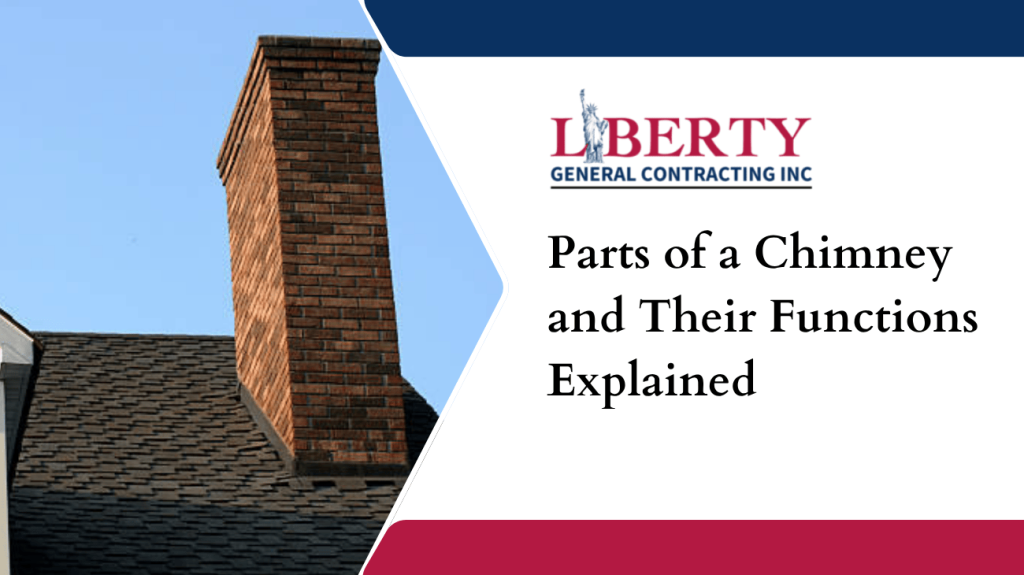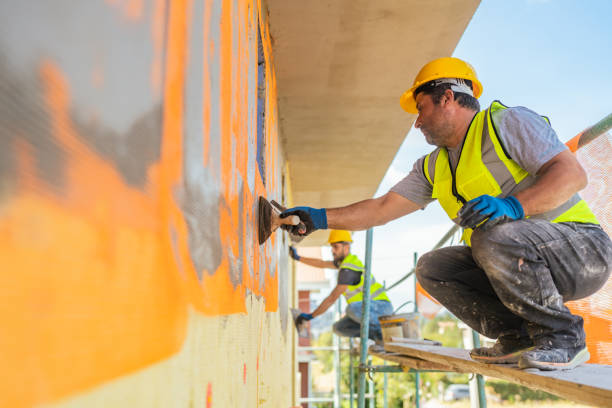Have you ever wondered what’s really going on inside your chimney? At first glance, it might seem like nothing more than a brick column on your roof. But there’s so much more to it. Every chimney is made up of multiple parts, each playing a vital role in keeping smoke out of your home and ensuring your fireplace works safely. In this guide, we’ll break down the parts of a chimney and their functions explained in simple terms—perfect for any homeowner curious about how their chimney works. And if you notice cracks, loose bricks, or other issues, don’t wait—our Chimney Services can help keep your chimney solid and safe.
Table of Contents
In this guide, we’ll walk you through the main parts of a chimney, explain their functions in detail, and help you understand why they matter for your home.
Why It’s Important to Understand the Parts of a Chimney
Many homeowners only pay attention to their chimney when they notice a problem—like smoke backing up into the room or a leaky ceiling. However, understanding how your chimney works can help you:
- Spot early signs of wear and tear before they become expensive repairs.
- Keep your fireplace running smoothly and safely.
- Ask the right questions during chimney inspections or repairs.
Let’s break down the key parts of a chimney from top to bottom and see what each one does.
The Main Parts of a Chimney and Their Functions

1. Chimney Cap: Your First Line of Defense
The chimney cap sits right at the top and acts like a shield. It keeps rain, snow, and even small animals like birds and squirrels from entering your chimney. Without a chimney cap, water can seep in and cause serious damage over time. Among all the parts of a chimney and their functions explained, the cap is one of the most crucial for protecting the structure from the elements.
Function:
- Prevents rain, snow, and debris from entering the chimney.
- Stops animals like birds, squirrels, and raccoons from nesting inside.
- Blocks sparks from escaping and landing on your roof, which reduces the risk of a fire.
If your chimney doesn’t have a cap, water and debris can cause serious damage over time.
2. Chimney Crown: Protecting the Top of Your Chimney
Right below the cap, you’ll find the chimney crown. This is the sloped concrete or masonry layer that seals off the top of the chimney. Its main job is to direct water away from the chimney’s sides to prevent erosion. Cracks in the crown are a common issue and should be repaired promptly to avoid costly damage.
Function:
- Directs water away from the flue and masonry to prevent leaks.
- Protects the bricks and mortar from cracking due to water penetration.
A damaged or cracked crown is one of the most common causes of chimney leaks.
3. Flue: The Main Passageway for Smoke
The flue is the inner passageway inside the chimney that carries smoke and gases out of your home.
Function:
- Provides a safe channel for combustion byproducts like smoke and carbon monoxide to escape.
- Maintains proper airflow (draft) for your fireplace to burn efficiently.
A clogged or damaged flue can cause dangerous smoke backup inside your home.
4. Flue Liner: A Crucial Safety Feature
The flue liner is a protective layer inside the flue, usually made of clay tiles, ceramic, or stainless steel.
Function:
- Shields the chimney walls from extreme heat and acidic byproducts.
- Helps contain sparks and embers, reducing the risk of chimney fires.
Older chimneys may not have liners, but modern building codes require them for safety.
5. Smoke Chamber: Guiding Smoke Upward
Located just above the firebox, the smoke chamber acts like a funnel, directing smoke from the fireplace into the narrower flue.
Function:
- Reduces turbulence and ensures smooth upward movement of smoke.
- Improves draft efficiency so smoke doesn’t spill into your living space.
If the smoke chamber is cracked or uneven, it can disrupt airflow and cause smoky rooms.
6. Damper: Controlling Airflow
The damper is a metal plate located at the base of the flue or at the top of the chimney. It can be opened or closed as needed.
Function:
- Opens when you’re using the fireplace to let smoke escape.
- Closes when the fireplace isn’t in use to keep cold air, rain, and pests out.
A faulty or stuck damper is a common issue that can lead to drafts and energy loss.
7. Firebox: The Heart of Your Fireplace
The firebox is the part of the fireplace where the fire actually burns. It’s usually made of fire-resistant brick and mortar.
Function:
- Contains the fire safely and protects surrounding walls from extreme heat.
- Supports proper airflow to maintain an efficient burn.
Regular inspection of the firebox is crucial to prevent cracks and deterioration.
8. Chimney Stack: The Visible Structure Above Your Roof
The chimney stack is the visible portion of the chimney that extends above your roofline.
Function:
- Provides height for proper draft, which helps pull smoke out of your home.
- Protects the flue and inner components from the elements.
Loose or missing bricks in the stack can lead to structural issues and should be repaired promptly.
9. Flashing: Keeping Water Out
Flashing consists of metal strips installed where the chimney meets the roof.
Function:
- Creates a watertight seal to prevent leaks around the chimney base.
- Protects your roof and ceiling from water damage.
Over time, flashing can loosen or corrode, making it a common source of roof leaks.
Common Problems in Chimney Parts
Even the best-built chimneys can develop problems over time. Some of the most frequent issues include:
- Cracks in the chimney crown allowing water to seep in.
- Rusted or missing chimney caps leading to debris and animal intrusion.
- Creosote buildup in the flue, which increases the risk of chimney fires.
- Damaged flashing causing water leaks around the chimney.
Annual inspections and regular maintenance can help catch these issues early.
How to Keep Your Chimney in Good Condition
To ensure your chimney stays safe and efficient:
- Schedule annual chimney inspections with a certified chimney sweep.
- Have the flue cleaned regularly to remove creosote buildup.
- Check for visible damage to the crown, flashing, and brickwork after storms.
- Replace or repair damaged parts promptly to avoid bigger issues.
A little maintenance goes a long way in extending your chimney’s lifespan.
Frequently Asked Questions About Chimney Parts
What are the main parts of a chimney?
The main parts of a chimney include the chimney cap, crown, flue, liner, flashing, smoke chamber, damper, and firebox. Each part plays a critical role in venting smoke, protecting your home from water damage, and ensuring safe fireplace operation. Understanding the parts of a chimney and their functions explained in this guide can help you spot issues early.
Why is the chimney liner so important?
The chimney liner acts as a protective barrier between the hot gases in the flue and the masonry walls. Without it, heat and creosote buildup could cause serious damage or even lead to a chimney fire. Regular inspection and cleaning of the liner are key parts of chimney maintenance.
How often should I get my chimney inspected?
Experts recommend having your chimney inspected at least once a year, especially before the start of the burning season. This helps identify any damage to critical chimney components like the crown, flashing, or flue liner and ensures your system operates safely.
What happens if a chimney part is damaged?
If any part of a chimney—like the cap, crown, or flashing—is damaged, it can lead to serious problems like water leaks, smoke entering your home, or even structural damage. Timely repairs by professionals can prevent small issues from turning into expensive repairs.
Final Thoughts
A chimney is much more than just a decorative feature on your roof—it’s a vital system that keeps your home safe and comfortable. By understanding the parts of a chimney and their functions, you can take better care of it and avoid expensive repairs.
Whether you’re lighting a cozy fire in winter or preparing your home for the off-season, knowing how your chimney works is key to keeping your family safe.
Contact Liberty GCNY
Website: www.libertygcny.com
Phone: (347) 682-9840
Serving: Manhattan, Brooklyn, Queens, The Bronx, Westchester County, and Long Island.
Address: 251 N Regent St, Port Chester, NY 10573, United States
Need Help with Your Next Project? Call Liberty GCNY Today!
Fast responses. Expert advice. Trusted service across NYC and beyond.


